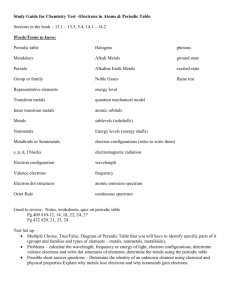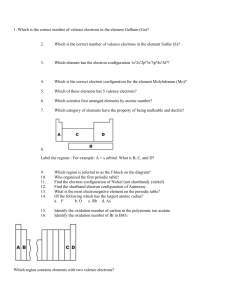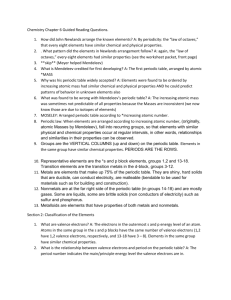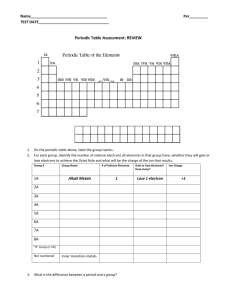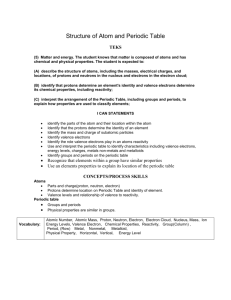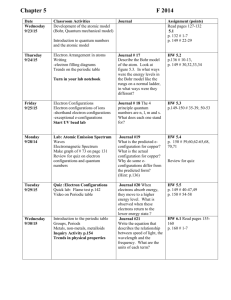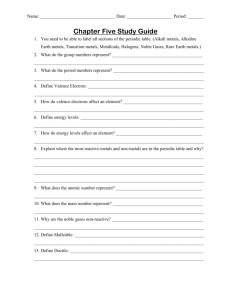Chapter 5
advertisement
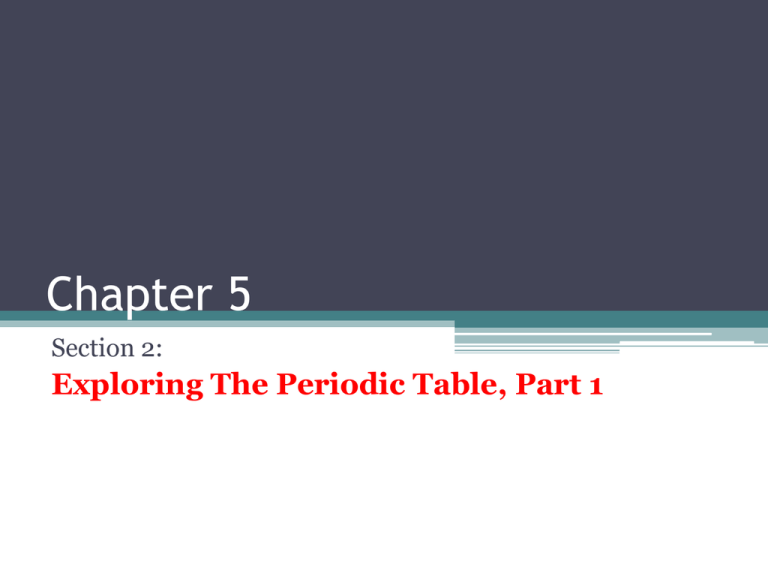
Chapter 5 Section 2: Exploring The Periodic Table, Part 1 Follow along The Role of Electrons 〉Why do elements within a group of the periodic table have similar chemical properties? 〉The periodic trends in the periodic table are the result of electron arrangement. The Role of Electrons, continued • Valence electrons account for similar properties. • An element’s location in the periodic table is related to electron arrangement. ▫ Example: Lithium and sodium, in Group 1, each have one valence electron. Visual Concept: Valence Electrons Ion Formation 〉What happens to an atom that gains or loses electrons? 〉If an atom gains or loses electrons, it no longer has an equal number of electrons and protons. Because the charges do not cancel completely, the atom has a net electric charge. Ion Formation, continued • Group 1 elements form positive ions. ▫ The single valence electron is easily removed. • Group 17 elements form negative ions. ▫ The addition of one valence electron fills the outer energy level. For Homework • Page 169 Vocabulary Words Chapter 5 Section 2: Exploring The Periodic Table, Part 2 Bellringer Each square on the periodic table of elements includes an element’s name, chemical symbol, atomic number, and atomic mass. Below are examples of elements found on the periodic table. Bellringer, continued 1. Which element above has the highest atomic number? Barium, 56 2. Which element above has the lowest atomic mass? Magnesium, 12 3. What is the chemical symbol for calcium? Ca 4. What is the element name for Cr? Chromium Open up to page 151 and follow along How Are Elements Classified? 〉What are the three main categories of elements? 〉All elements are either metals, nonmetals, or semiconductors. How Are Elements Classified?, continued • Elements in each category have similar properties. ▫ metal: an element that is shiny and that conducts heat and electricity well ▫ nonmetal: an element that conducts heat and electricity poorly ▫ semiconductor (or metalloid): an element or compound that conducts electric current better than an insulator does but not as well as a conductor does Visual Concept: Comparing Metals, Nonmetals, and Metalloids Properties of Metals • Good conductors of heat & electricity • They are ductile (can be turned into wires) and malleable (easily bent or shaped) • Most are shiny Properties of Nonmetals • Poor conductors of heat & electricity • Not malleable or ductile • Most are not shiny Properties of Semiconductors • Share properties of metals and nonmetals • Conduct electricity under certain conditions • Main components in computer chips and other electronic devices How Are Elements Classified?, continued For Homework • Section Review, 1-8, page 155



